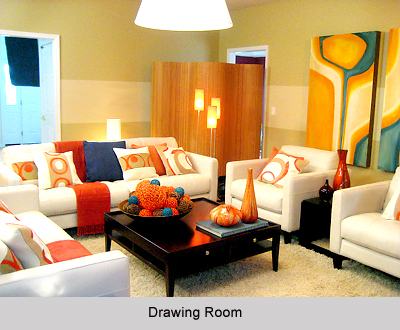 Vastu Shastra is an art and science that is as old as the Vedic Age. References to it has been found in the texts that date back to this era. `Vaasthu` in Sanskrit refers to `Vasthu` meaning a commodity. Shastra means system in Sanskrit. Vastu may also refer to `vaas` (to live). This ancient science has laid down several rules following which will lead to a harmonious existence for the living beings. These rules pertain to the construction of houses and even work places.
Vastu Shastra is an art and science that is as old as the Vedic Age. References to it has been found in the texts that date back to this era. `Vaasthu` in Sanskrit refers to `Vasthu` meaning a commodity. Shastra means system in Sanskrit. Vastu may also refer to `vaas` (to live). This ancient science has laid down several rules following which will lead to a harmonious existence for the living beings. These rules pertain to the construction of houses and even work places.
The living rooms in a flat are an important section. If the residents follow certain principles of Vastu Shastra it can generate positive energy in their houses.
•The living rooms should be in the east (leaving the south-east corner) or in the north. It would be more beneficial if they are located in the north side of the flat.
•The slope of the floors in the living room should either be in the east or in the north.
•The doors of the living rooms should not be constructed in the south-east or the south-west directions.
•Built the doors in the eastern and the western sides as this would prove very auspicious for the living rooms.
•The furniture, show cases and other heavy articles should be placed in the west or the south directions.
• Circular, triangular, egg shaped, hexagonal or odd shaped furniture in the living rooms should be avoided. These should either be square or rectangular.
•In case there is a separate sitting arrangement for the head of the family it should be in the east or in the north directions.
•T.V. should be in the south-east corner. It is better not to put T.V. in the north-east or the south-west corners. If it is in the north-west corner and remains on for a long time a lot of valuable time is lost. If the T.V. is in the south-west corner frequent breakdowns are expected.
•The telephone should be in the east or in the south-east or in the north.
•If the residents have arranged for the Indian style of sitting then it should be placed in the east, the west or the north.
•Portraits of God or other images should be hung in the north-east corner of the living rooms.
•Stuffed animals should be placed in the north-west corner.
•Colours that can be used on the walls can be white, yellow, blue or green. Tiles of similar colors can also be used. Avoid using red or black colors in the living rooms.
•Do no hang fancy chandelier at the centre of the room. It should be placed slightly towards the west. The logic behind this is that due to the gravitational force acting on this heavy item it should not fall at Bramha`s place. the center of a rooms is considered to be Lord Brahma`s, according to Vastu Shastra.
•Portraits of birds, animals, women, weeping children, scenes from wars and others should not be displayed in the living rooms.
•Do not put up photographs of any God at the entrance doors. In case someone is too keen, they can display the photograph or tile painting of the Lord Ganesha above the entrance door on the outside.
•Due to scarcity of space, if the furniture are to be kept in the east or in the north direction, they should not come in direct contact with the flooring. They should be light and hollow and placed on base that is 1-3 inches above the floor.
•It is also favorable to have the ceiling a bit slanting to the east or the north. This rule is completely optional.
•There should be no outlet in the middle of the room.
•As far as the coolers are concerned they should be placed in the west direction and not in the south-east section.
•According to the principles of modern architecture the height of the living room is usually more than that of the other rooms. There is no harm in doing so.
•If there are staircases adjacent to the living rooms they should be in the south, the west or the south-west corner of the room. They should be rise up towards the south or the west directions.




















